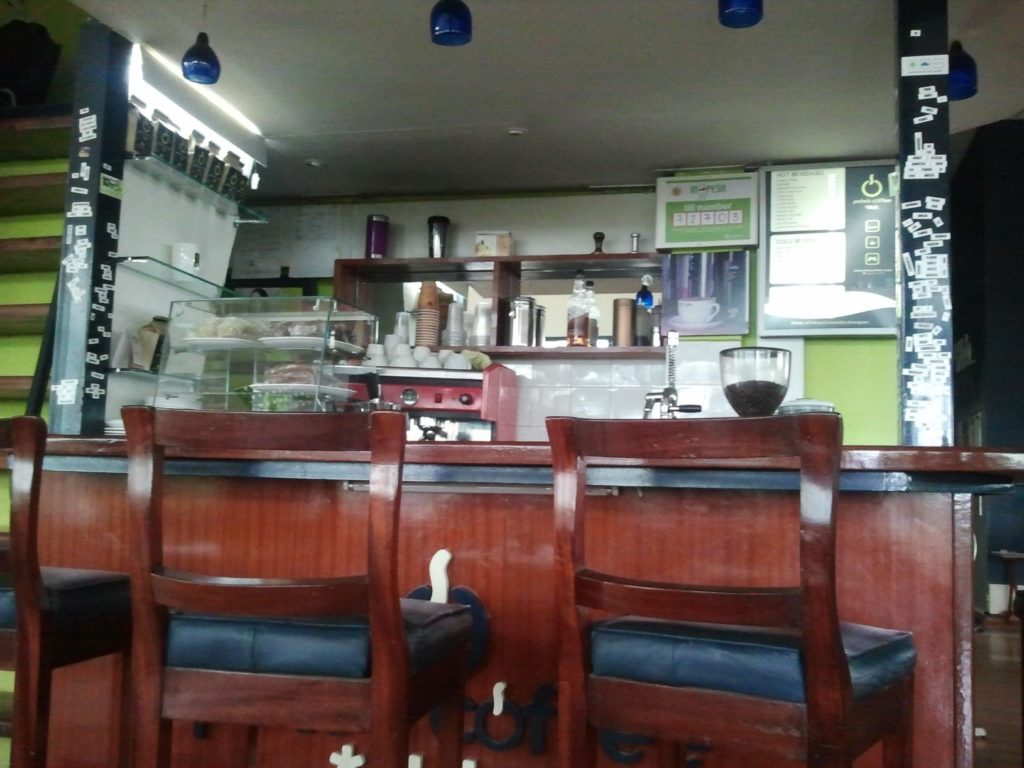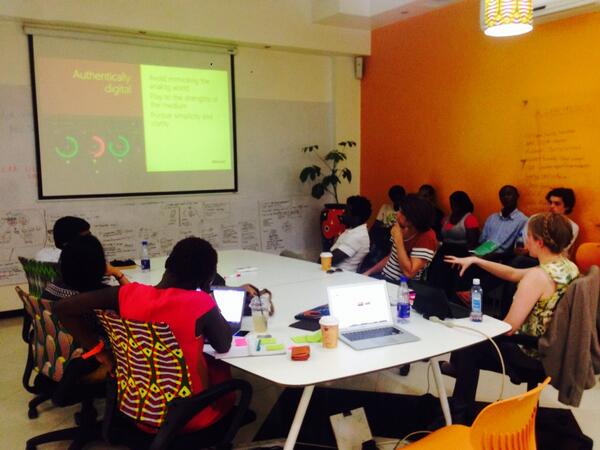The primary reason I’m in Africa is as a volunteer for the Microsoft4Afrika program. One part of their outreach is to match professionals from Microsoft with identified technology needs in African countries. Many of the assignments are either teaching advanced skills or helping with infrastructure and IT needs.
For my own part, I was matched with a request from the iHub in Nairobi for user experience training on developing products for Microsoft platforms. I’ve spent the better part of the last month preparing my curriculum from scratch – though I do teach an intro to interaction design workshop back in the States, it’s far more rudimentary than what the folks at iHub will benefit from.
The iHub Coworking Space
The iHub is a fascinating, energizing place. They’ve taken over a large part of an office tower, with the 4th floor as the central meeting/working space, and dedicated spaces on other floors: the 3rd floor is a mobile device development lab and a series of offices for promising startups; the 2nd floor is the home of iHub Research, and the 1st floor is the home of the iHub UX Lab.

The 4th floor area brings startup culture immediately to mind. It’s a wide open loft, with vaulted ceiling and makeshift modular layout – in its neutral state there are many working desks, beanbags, benches and gaming chairs, while it can be partitioned into a partial theater space for presentations when needed. The space is surrounded by a terrace that looks out on Nairobi, and the doors and windows are usually flung open to keep the air circulating in the afternoon heat.
The 4th floor also boasts an espresso bar, with a barista named Rose who is much beloved amongst the iHub’s citizenry. Prices are good and Rose takes pride in her work.
My host, Mark Kamau (the UX director of the iHub) explained the history of how the organization was founded. Years ago during a period of political unrest, the government instituted a media blackout, which caused some panic amongst citizens who became cut off from family and friends. Four technologists, seeing the problem, pooled resources to develop a mobile app to connect those disconnected citizens. Once the unrest was over, the four looked at what they had achieved and wondered if that impact could be magnified by creating a community where other technologists could share their talents and ideas. Over time, the iHub began providing training in addition to the community environment, and now they’ve got almost 10,000 members across several sites.
The UX lab here is a relatively new addition to the iHub. Billed as the first of its kind in sub-Saharan Africa, they provide user experience consulting services and research to startups, as well as bringing in a wide variety of training opportunities. Past topics have covered subjects like participatory design and persona development, amongst many others. The space itself is a conference room ringed with whiteboards (and a door directly to another coffee bar next door), a small room used for usability studies, and a medium-sized room used for breakouts and focus groups.
What I’m teaching

For my contribution, I’ve developed 4 approximate 2-hour workshops that cover a variety of topics; some specific to Microsoft and some more general.
DAY 1: Overview – Basics of design for Microsoft
Process, design principles, interaction model and design patterns, plus some discussion about the recent changes from Build 2014
DAY 2: Storytelling and the Human Form
Introduction to natural user interfaces; deep dives on scenario-focused design including personas, storyboarding and sketching; discussion of some disruptive technologies, and a mini improv workshop to develop storytelling skills
DAY 3: Psychology of Design
Cognitive psychology basics, demystifying gamification, motivational design and possibly another mini-improv workshop
DAY 4: Visual Design for Modern UI
Basic visual design techniques and principles; discussion of typography, grid systems, colors and iconography specific to the Microsoft community
As with any endeavor of this kind, the content might change wildly by later in the week based on feedback. The classes are condensed to fit in with the busy lives the potential attendees live – most work during the day and can’t take a full day off for a slower-paced class with more hands-on material.
I find myself relieved that I wasn’t relying heavily on video content, since as luck would have it the main connectivity fiber cable to iHub was cut, forcing them to drop to a much slower, secondary connection. It seems there’s no estimate on a fix. Remarkably, folks here still seem to be very productive at first glance, and there’s very little complaining. The same was true on Monday, when the Internet was fine but power outages kept hitting all afternoon. Folks here appreciate what they have and work around it when those things are gone. Microsofties – well, smart as we are, we really can’t seem to handle it when the Internet goes down for 10 minutes. 😉
I’ll report back on the progress the classes have made, and I hear the iHub will be blogging about my classes as well. I’ll make sure to share those posts once they’ve become available for a different perspective on this teaching journey.
